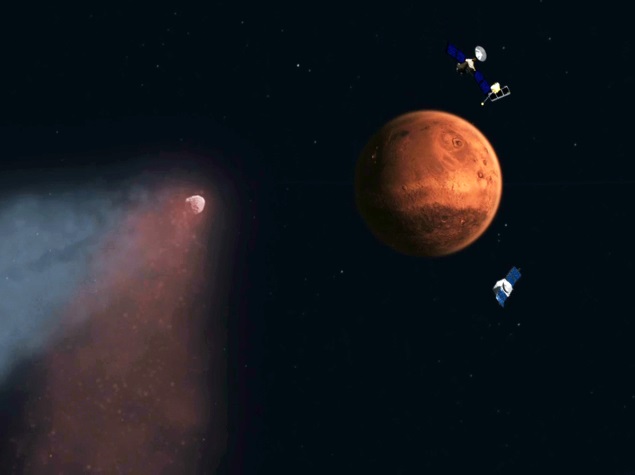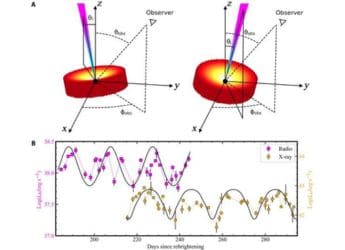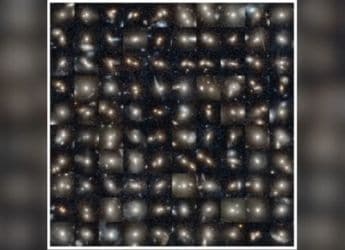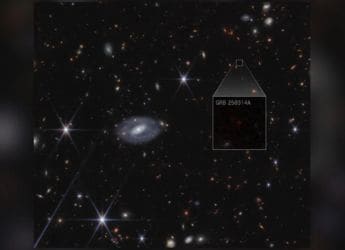- Home
- Science
- Science News
- Siding Spring Comet Bombarded Mars Sky With Meteor Shower: Nasa
Siding Spring Comet Bombarded Mars Sky With Meteor Shower: Nasa

New Nasa data from satellites circling Mars shows that when the comet named Siding Spring skimmed the red planet, tons of comet dust bombarded the Martian sky with thousands of fireballs an hour. It warped the Martian atmosphere leaving all sorts of metals and an eerie yellow afterglow on Oct. 19.
A meteor shower from magnesium, sodium, iron and five other metals may have been so heavy that it might be even considered a meteor storm, said University of Colorado scientist Nick Schneider. Spikes in magnesium physically changed the atmosphere around Mars, while sodium left a yellowish glow in the sky after the meteor showers finished, he said.
"It would have been truly stunning to the human eye," said Schneider, who was the lead instrument scientist for one of Nasa's Martian satellites. "It would have been really mind-blowing."
The best view would have been from the Martian surface, where Nasa had the rovers Opportunity and Curiosity looking up. But the rovers could only take stills, said agency chief planetary scientist Jim Green. There was no video to capture the shooting stars that made it a spectacular light show.
Instead, Nasa's satellites recorded lots of scientific data, which allowed astronomers to describe what it must have been like.
The core of the spinning comet moved by Mars at more than 125,000 mph (201,200 kph) and could have been as large as 1.2 miles (2 kilometers) wide, astronomers said.
It was not only big, but the dust assault was far larger than Nasa anticipated, Green said. Nasa's models estimated that the dust would not be enough to harm the satellites around Mars, but the agency moved them to the other side of the planet just in case. That turned out to be wise, he said.
The comet came from the Oort Cloud, which is at the very edge of our solar system. Comets from there are rare so this was the type of event that happens once every 8 million years. And when they come toward the sun they aren't as dusty as others, more pristine, astronomers said.
"We never before had the opportunity to observe an Oort Cloud comet up close," Green said. "Instead of going to the comet, it came to us."
Get your daily dose of tech news, reviews, and insights, in under 80 characters on Gadgets 360 Turbo. Connect with fellow tech lovers on our Forum. Follow us on X, Facebook, WhatsApp, Threads and Google News for instant updates. Catch all the action on our YouTube channel.
Related Stories
- Samsung Galaxy Unpacked 2025
- ChatGPT
- Redmi Note 14 Pro+
- iPhone 16
- Apple Vision Pro
- Oneplus 12
- OnePlus Nord CE 3 Lite 5G
- iPhone 13
- Xiaomi 14 Pro
- Oppo Find N3
- Tecno Spark Go (2023)
- Realme V30
- Best Phones Under 25000
- Samsung Galaxy S24 Series
- Cryptocurrency
- iQoo 12
- Samsung Galaxy S24 Ultra
- Giottus
- Samsung Galaxy Z Flip 5
- Apple 'Scary Fast'
- Housefull 5
- GoPro Hero 12 Black Review
- Invincible Season 2
- JioGlass
- HD Ready TV
- Laptop Under 50000
- Smartwatch Under 10000
- Latest Mobile Phones
- Compare Phones
- Redmi Note 15 5G
- Redmi Note 15 Pro 5G
- Redmi Note 15 Pro+ 5G
- Lava Play Max
- Poco C85 5G
- Honor Magic 8 Lite
- Jolla Phone
- Realme P4x 5G
- Asus ProArt P16
- MacBook Pro 14-inch (M5, 2025)
- OnePlus Pad Go 2
- Poco Pad M1
- Just Corseca Skywatch Pro
- Honor Watch X5
- Acerpure Nitro Z Series 100-inch QLED TV
- Samsung 43 Inch LED Ultra HD (4K) Smart TV (UA43UE81AFULXL)
- Asus ROG Ally
- Nintendo Switch Lite
- Haier 1.6 Ton 5 Star Inverter Split AC (HSU19G-MZAID5BN-INV)
- Haier 1.6 Ton 5 Star Inverter Split AC (HSU19G-MZAIM5BN-INV)

















